Статьи журнала - International Journal of Image, Graphics and Signal Processing
Все статьи: 1056
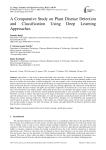
A Comparative Study on Plant Disease Detection and Classification Using Deep Learning Approaches
Статья научная
Agriculture is a big sector in nations like India, and it provides a living for many people. To improve crop productivity, it’s very necessary to identify and classify plant diseases and prevent them from spreading further so that they do not affect the whole plant. Artificial intelligence (AI) and computer vision can help detect plant diseases that humans cannot always catch and overcome the shortcomings of continuous human monitoring. In this article, we aim to detect and classify diseases in tomato and apple leaves using deep learning approaches and compare the results between different models. Because tomatoes and apples are important components of the human diet, crop waste can result in losses for both farmers and ordinary people. These plant diseases have an immediate and negative impact on both the amount and quality of yield. Crop diseases must be identified and prevented as soon as possible to improve crop yield. Therefore, we need to monitor and analyze the growth stages of the plants so that the farmers can produce disease-free and with minimal losses to the crop. Furthermore, we used the sequential convolutional neural network (CNN) model followed by transfer learning models like VGG19, Resnet152V2, Inception V3, and MobileNet and compared the models based on accuracy. The performance of the models was evaluated using various factors such as dropout, batch size, and the number of epochs. For both, the datasets, the tomato, and apple MobileNet architecture performed better than the other existing models.
Бесплатно
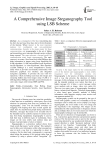
A Comprehensive Image Steganography Tool using LSB Scheme
Статья научная
As a consequence of the fact, transmitting data has been fast and easy these days due to the development of the Internet. Where internet is the most important medium for confidential and non-confidential communications. Security is the major matter for these communications and steganography is the art of hiding and transmitting secret messages through carriers without being exposed. This paper presents a secured model for communication using image steganography. The main concern is to create a Java-based tool called IMStego that hides information in images using Least Significant Bit (LSB) algorithm (1-LSB) and modified Least Significant one Bit algorithm, i.e. Least Significant 2 Bits algorithm (2-LSB). IMStego is a more comprehensive security utility where it provides user-friendly functionality with interactive graphical user interface and integrated navigation capabilities. It provides the user with two operations, which are hiding secret data into images and extracting hidden data from images using 1-LSB or 2-LSB algorithm. IMStego tool hides secrete information in color static images with formats BMP and PNG.
Бесплатно
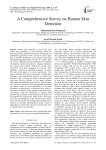
A Comprehensive Survey on Human Skin Detection
Статья научная
Human Skin detection is one of the most widely used algorithms in vision literature which has been numerously exploited both directly and indirectly in multifarious applications. This scope has received a great deal of attention specifically in face analysis and human detection/tracking/recognition systems. As regards, there are several challenges mainly emanating from nonlinear illumination, camera characteristics, imaging conditions, and intra-personal features. During last twenty years, researchers have been struggling to overcome these challenges resulting in publishing hundreds of papers. The aim of this paper is to survey applications, color spaces, methods and their performances, compensation techniques and benchmarking datasets on human skin detection topic, covering the related researches within more than last two decades. In this paper, different difficulties and challenges involved in the task of finding skin pixels are discussed. Skin segmentation algorithms are mainly based on color information; an in-depth discussion on effectiveness of disparate color spaces is elucidated. In addition, using standard evaluation metrics and datasets make the comparison of methods both possible and reasonable. These databases and metrics are investigated and suggested for future studies. Reviewing most existing techniques not only will ease future studies, but it will also result in developing better methods. These methods are classified and illustrated in detail. Variety of applications in which skin detection has been either fully or partially used is also provided.
Бесплатно
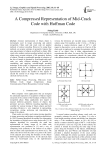
A Compressed Representation of Mid-Crack Code with Huffman Code
Статья научная
Contour representation of binary object is increasingly used in image processing and pattern recognition. Chain code and crack code are popular methods of contour encoding. However, by using these methods, an accurate estimate of geometric features like area and perimeter of objects are difficult to obtain. Mid-crack code, another contour encoding method, can help to obtain more accurate estimate of the geometric features of objects. Though a considerable amount of reduction of the size of images is obtained by fixed-length mid-crack code, yet, more efficient encoding is possible by considering and applying variable-length encoding technique. In this paper, a compressed mid-crack code is proposed based on the Huffman code. Experiments performed on different images yield that the proposed representation reduces the number of bits require to encode the contour of an image with compared to the classical mid-crack code.
Бесплатно
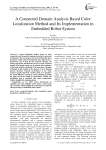
Статья научная
A target localization method based on color recogni-tion and connected component analysis is presented in this paper. The raw image is converted to HSI color space through a lookup table and binarized, then followed by a line-by-line scan to find all the connected domains. By setting appropriate threshold for the size of each connected domain, most pseudo targets can be omitted and coordinates of the target could be calculated in the mean time. The main advantage of this method is the absence of extra filtering process, therefore real-time performance of the whole system is greatly improved. Another merit is we introduce the frame difference concept to avoid manually presetting the upper and lower bound for binarization. Thirdly, the localization step is combined with target enumeration, further simplified the implementation. Experiments on our ARM system demonstrate its capability of tracing multiple targets under a mean frame rate of 15FPS, which satisfied the requirement of real-time video processing on embedded robot systems.
Бесплатно
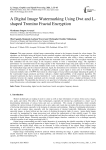
A Digital Image Watermarking Using Dwt and L-shaped Tromino Fractal Encryption
Статья научная
This paper presents a digital image watermarking scheme in the frequency domain for colour images. The algorithm was developed using the digital wavelet transform together with fractal encryption. A host image was first transformed into a frequency domain using the discrete wavelet transform after which a binary watermark was permuted and encrypted with a fractal generated from the watermark and a random key. The encrypted watermark is then embedded into the host image in the frequency domain to form a watermarked image. The algorithm’s performance was examined based on the image quality of the watermarked image using peak signal to noise ratio. A perceptual metrics called the structural similarity index metric was further used to examine the structural similarity of the watermarked image and the extracted watermark. Again, the normalised cross-correlation was introduced to further assess the robustness of the algorithm. Our algorithm produced a peak signal to noise ratio of 51.1382dB and a structural similarity index of 0.9999 when tested on colour images of Lena, baboon and pepper indicating the quality of the watermarked images produced and hence indicates a higher imperceptibility of the proposed algorithm. The extracted watermark also had a structural similarity of 1 and a normalised cross correlation of 1 indicating a perfect similarity between the original watermark and the extracted watermark hence shows a higher performance of the proposed algorithm. The algorithm also showed a very good level of robustness when various attacks such as Gaussian noise, Poisson noise, salt and pepper noise, speckle noise and filtering were applied.
Бесплатно
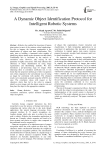
A Dynamic Object Identification Protocol for Intelligent Robotic Systems
Статья научная
Robotics has enabled the lessening of human intervention in most of the mission critical applications. For this to happen, the foremost requirement is the identification of objects and their classification. This study aims at building a humanoid robot capable of identifying objects based on the characters on their labels. Traditionally this is facilitated by the analysis of correlation value. However, only relying on this parameter is highly error-prone. This study enhances the efficiency of object identification by using image segmentation and thresholding methods. We have introduced a pre-processing stage for images while subjecting them to correlation coefficient test. It was found that the proposed method gave better recognition rates when compared to the conventional way of testing an image for correlation with another. The obtained results were statistically analysed using the ANOVA test suite. The correlation values with respect to the characters where then fed to the robot to uniquely identify a given image, pick the object using its arm and then place the object in the appropriate container.
Бесплатно
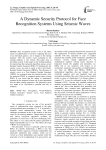
A Dynamic Security Protocol for Face Recognition Systems Using Seismic Waves
Статья научная
Face recognition system is one of the robust means of authentication. It involves comparing the faces of an individual against a set of images in the training database. Thus the security issues pertaining to the training database is very critical. This paper aims at providing security to the images in the training database by empowering the encryption algorithms using a secure Random Number Generator (RNG). To facilitate this, the seismic waves are used as seeds to drive the Pseudo-Random Number Generators (PRNGs). The efficiency of seismic waves as a True Random Number Generator (TRNG) was evaluated using two statistical suites. Also, the proposed TRNG is compared against other existing RNGs. It was found that the degree of randomness rendered by the proposed system was in good agreement like the other existing generators. The proposed system was found to be cost-effective, portable and easy to maintain.
Бесплатно
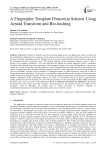
A Fingerprint Template Protection Scheme Using Arnold Transform and Bio-hashing
Статья научная
Fingerprint biometric is popularly used for protecting digital devices and applications. They are better and more reliable for authentication in comparison to the usual security tokens or password, which make them to be at the forefront of identity management systems. Though, they have several security benefits, there are several weaknesses of the fingerprint biometric recognition system. The greatest challenge of the fingerprint biometric system is theft or leakage of the template information. Also, each individual has limited and unique fingerprint which is permanent throughout their lifespan, hence, the compromise of the fingerprint biometric will cause a lifetime threat to the security and privacy of such an individual. Security and privacy risk of fingerprint biometric have previously been studied in the context of cryptosystem and cancelable biometric generation. However, these approaches do not obviously address the issue of revocability, diversity and irreversibility of fingerprint features to guard against the wrong use or theft of fingerprint biometric information. In this paper, we proposed a model that harnesses the strength of Arnold transform and Bio-hashing on fingerprint biometric features to overcome the limitations commonly encountered in sole fingerprint biometric approaches. In the experimental analysis, the result of irreversibility showed 0% False Acceptance Rate (FAR), performance showed maximum of 0.2% FAR and maximum of 0.8% False Rejection Rate (FRR) at different threshold values. Also, the result of renewability/revocability at SMDKAB SMKADKB and SMKBDKA showed that the protection did not match each other. Therefore, the performance of the proposed model was notable and the techniques could be efficiently and reliably used to enforce protection on biometric templates in establishments/organizations so that their information and processes could be secured.
Бесплатно
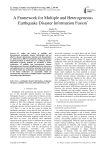
A Framework for Multiple and Heterogeneous Earthquake Disaster Information Fusion
Статья научная
To realize the fusion of multiple and heterogeneous earthquake disaster information and get effective disaster information, situation and characteristics are addressed on different earthquake disaster information acquiring methods, in which some new earthquake disaster information acquiring methods are described. A fusion architecture of multiple and heterogeneous disaster information is put forward, including data level, fusion level and application level. And function principle of each level is described. Finally key technologies and realization methods in the fusion architecture are expounded, which are transformation and match of multiple disaster information and coding of the information.
Бесплатно
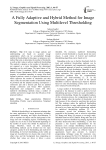
A Fully Adaptive and Hybrid Method for Image Segmentation Using Multilevel Thresholding
Статья научная
High level tasks in image analysis and understanding are based on accurate image segmentation which can be accomplished through multilevel thresholding. In this paper, we propose a new method that aims to determine the number of thresholds as well as their values to achieve multilevel thresholding. The method is adaptive as the number of thresholds is not required as a prior knowledge but determined depending on the used image. The main feature of the method is that it combines the fast convergence of Particle Swarm Optimization (PSO) with the jumping property of simulated annealing to escape from local optima to perform a search in a space the dimensions of which represent the number of thresholds and their values. Only the maximum number of thresholds should be provided and the adopted encoding encompasses a continuous part and a discrete part that are updated through continuous and binary PSO equations. Experiments and comparative results with other multilevel thresholding methods using a number of synthetic and real test images show the efficiency of the proposed method.
Бесплатно
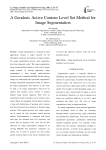
A Geodesic Active Contour Level Set Method for Image Segmentation
Статья научная
Image segmentation is a vital part of many applications because it makes possible for the information extraction and analysis of image contents. For image segmentation process, many approaches have been proposed earlier. The image segmentation using normal standard methods is well only for simple image contents. In existing approaches image segmentation is done through multi-resolution stochastic level set method (MSLSM), but the topology changes are undesirable and it presented nonparametric topology-constrained segmentation model. To improve the image segmentation more effective, in this work, we plan to do image segmentation using level set method with geodesic active contour to analyze medical image disease diagnosis. With level set segmentation based on geodesic active contour, active cluster objects are segregated. Cluster object formation is done with fuzzification of growing active contours with the previously known contours of diseased image portions. With segment portions new similar regions can be traced out with automatic seeded growing method. Experimentation is conducted with bench mark data sets obtained from UCI repository and proved that the proposed GAC work will be 80% efficiency for image segmentation compared to an existing MSLSM. The parametric evaluations are carried over in terms of segment size and contour growth, Contour objects in the cluster, Similarity ratio of known and unknown contours, Seed size of the detected contours.
Бесплатно
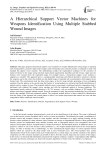
Статья научная
This paper proposes hierarchical support vector machines for weapon Identification using images of repeated stab wound patterns caused by sharp metal weapons used in homicidal cases and also presents a comparative study with standard flat support vector machine. The methodology includes the segmentation technique for the extraction of region-of-interest in the image using transition region-based segmentation algorithm and then texture, shape and size features were extracted from the segmented image. For multiple classes, a hierarchical support vector machine is adapted as a classifier. This approach gives a computationally interesting and efficient alternative solution to identify the weapons used in the crime; this method uses the digital images of repeated stab wound patterns which appear on the human body. The experimental study has three main stages, at the first stage includes generating of non-overlapping segments from the pattern, at the second stage the features of wound patterns are extracted and finally identification of patterns and its weapon of cause. The proposed method accuracy assessment is performed and also comparison study is performed with standard flat support vector machine and with the traditional method of forensic pathology. The experimental results achieved for Identification is 96.71% accuracy, with an available database of 500 images of a pattern consisting of repeated stabbed wounds. From the comparative study, the proposed methodology has given better results than standard SVM and traditional method. The proposed method delivers a better solution for identification from the image of the repeated stab wound pattern as there is no human intervention that reduces the error and data manipulation unlike traditional manual method.
Бесплатно
Статья научная
Most of the steganography techniques, based on pixel value difference, use the difference between the pixel values to hide the information. In this paper, an algorithm is proposed which combines the LSB and PVD steganography techniques to provide high data hiding capacity with acceptable stego image quality. Instead of using the original difference to hide the information, the difference is revised before it is used for hiding the information. This introduces an additional layer of security for the secret information. The algorithm divides the cover image in the blocks of 2x3 pixels. One of the pixels in the block is used as common pixel, which forms five pixel pairs with remaining five pixels in the block. The algorithm hides three secret bits in the common pixel using the LSB substitution method and then use the PVD based approach to hide data in five pixel pairs in each block. The algorithm determines the average (N) of the number of bits that can be hidden in the block. If the difference value allows M-bits to be hidden in the pair, then bits ≤ N are hidden in that pair. The result shows that the algorithm provides higher hiding capacity with better PSNR values as compared to other methods investigated in this study.
Бесплатно
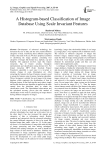
A Histogram-based Classification of Image Database Using Scale Invariant Features
Статья научная
Development of advanced technology has increased the size of data and has also created different categories of data. Classifying these different categories of data is the need of the era. We have proposed a method of classifying the image database containing four categories of images like human face, airplane, cup and butterfly. Our approach involves steps like feature extraction, bag of feature creation, histogram representation and classification using decision tree. For feature extraction SIFT (Scale Invariant Feature Transform) algorithm is used since it is invariant to rotation, change of scale, illumination etc. After extracting the features the bag of features concept is used to group the features using k-means clustering algorithm. Then a histogram is plotted for each image in the image database which represents the distributions of data in different clusters. In the final step the most robust, simple and flexible decision tree algorithm is applied on the table created from the histogram plots to obtain the classification result. The experimental observations and the calculated accuracy proves that this method of classification works well for classifying an image dataset having different categories of images.
Бесплатно
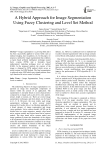
A Hybrid Approach for Image Segmentation Using Fuzzy Clustering and Level Set Method
Статья научная
Image segmentation is a growing field and it has been successfully applied in various fields such as medical imaging, face recognition, etc. In this paper, we propose a method for image segmentation that combines a region based artificial intelligence technique named fuzzy c-means (FCM) and a boundary based mathematical modeling technique level set method (LSM). In the proposed method, the contour of the image is obtained by FCM method which serves as initial contour for LSM Method. The final segmentation is achieved using LSM which uses signed pressure force (spf) function for active control of contour.
Бесплатно
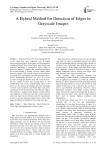
A Hybrid Method for Detection of Edges in Grayscale Images
Статья научная
Edge detection is the most fundamental but at the same time most important task in image processing and analysis. In the paper a hybrid approach combining Neural Network and Fuzzy logic based edge detection algorithm is proposed to detect edges in grayscale images. To improve the generalization ability, the neural network is trained on fuzzy inputs rather than crisp inputs. The network consists of three layers, one input layer, one hidden layer and one output layer. Fuzzy membership functions are used to convert neurons of input and hidden layer into fuzzy neurons. So the output of first and second layer is the membership value of the corresponding input in the fuzzy set. The proposed technique provides advantage of both neural networks and fuzzy logic and gives satisfactory results for both noisy and noise free images. The method is compared with Roberts, Prewitt, Sobel and Laplacian of Gaussian and other neural network and fuzzy logic based methods and the experimental results reveal that proposed method gives better edge map considering the problem of false edge detection.
Бесплатно
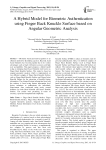
Статья научная
Biometric based personal recognition is an efficient method for identifying a person. Recently, hand based biometric has become popular due to its various advantages such as high verification accuracy and high user acceptability. This paper proposes a hybrid model using an emerging hand based biometric trait known as Finger Back Knuckle Surface. This model is based on angular geometric analysis which is implemented on two different samples of Finger Back Knuckle Surface such as Finger Bend Knuckle Surface and Finger Intact Knuckle Surface for the extraction of knuckle feature information. The obtained feature information from both the surfaces is fused using feature information level fusion technique to authenticate the individuals. Experiments were conducted using newly created database for both Bend Knuckle and Intact Knuckle Surface. The results were promising in terms of accuracy, speed and computational complexity.
Бесплатно

A Hybrid Restoration Approach of Defocused Image Using MGAM and Inverse Filtering
Статья научная
A novel hybrid restoration scheme of defocused image is presented, which uses multivariate generalized additive model (MGAM) which is a nonparametric statistical regression model with no curse of dimensionality and inverse filtering (InvF). In this algorithm, firstly the five features of wavelet domain in defocused digital image, which are very stable relationship with the point spread function (PSF) parameter, are extracted by training and fitting a multivariate generalized additive model which is to estimate defocused blurred parameter. After the point spread function parameter is obtained, inverse filtering, which is needed to known the point spread function and a non-blind restoration method, is applied to complete the restoration for getting the true image. Simulated and real blurred images are experimentally illustrated to evaluate performances of the presented method. Results show that the proposed defocused image hybrid restoration technique is effective and robust.
Бесплатно
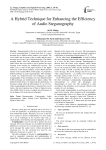
A Hybrid Technique for Enhancing the Efficiency of Audio Steganography
Статья научная
Steganography is the art or science that is used in secret communication. It means that there is a secret message that is hidden within another cover media. The cover media may be image, video or audio and the secret message may be any type of digital message. The hidden message doesn't have any relationship with the cover media where the cover media is just to protect the secret message from hacking by unauthorized receiver. The audio cover is used in this paper because of the higher sensitivity of the human auditory system (HAS) than the human visual system (HVS). In this paper, we proposed a hybrid technique to audio steganography. This technique is based on a hybrid between two techniques of audio steganography. These techniques are Least Significant Bit (LSB) technique and modification of phase coding. The hybrid between them is for improving the performance of the phase coding where the performance of it is very low. Audio steganography performance is measured by several factors, the most important one of them is Signal to noise ratio (SNR) which is used to compare the performance of our technique with some known techniques.
Бесплатно

